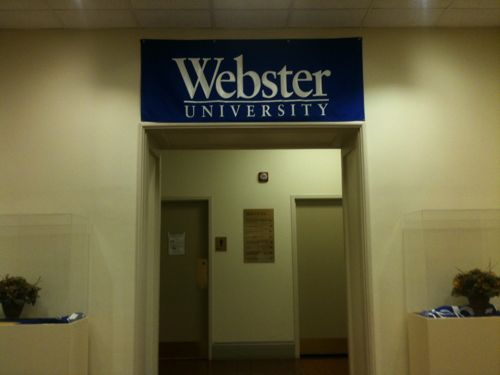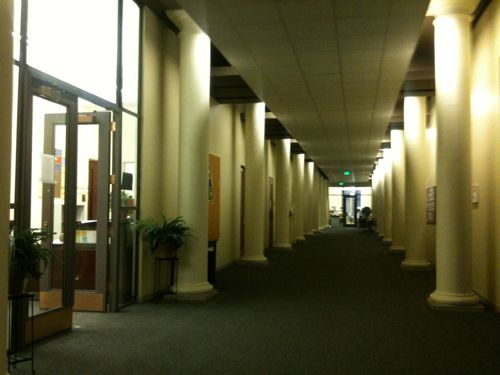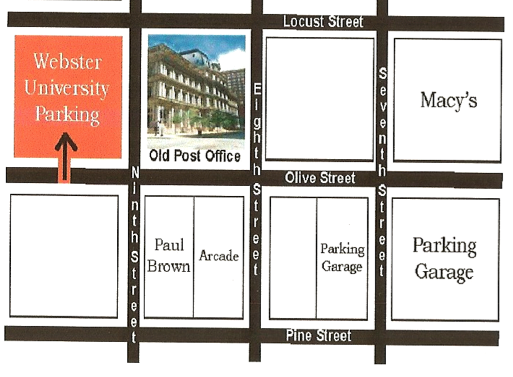Low Enrollment at Webster University’s Old Post Office Campus

Webster University’s main campus is in the St. Louis suburb of Webster Groves, but they’ve had a downtown campus for years. Â For a long time they had classeroom space in the Lammert Building at 911 Washington Ave.
Webster was a driving force behind the latest renovation of the Old Post Office and the razing of the historic Century Building across 9th Street for a parking garage. Â Back in 2003 the predictions were big & bold:
Webster plans to duplicate the programs offered on its Webster Groves campus when it opens in the Old Post Office building in 2005. Initially, about 1,200 students will attend classes at the Old Post Office, a number university President Richard Meyers expects to mushroom to 1,700 by 2007 or 2008.
That could create enough demand to justify building dormitories downtown — especially since the university’s latest dormitory project on its 47-acre Webster Groves campus will leave no space to develop more student housing. (St. Louis Business Journal)
Current enrollment? Only about 600, far from 1,700! Â Don’t look for any new downtown dormitories anytime soon, unless they can convince the state to pay for the construction and lease them to the university below market. Webster’s Old Post Office website.

I visited the Webster University space in the Old Post Office last week. Â Despite being a block from the 8th & Pine MetroLink light rail station, driving & parking is what is encouraged. Â I found two versions of a “campus parking” guide. Â These similar flyers give detailed driving & parking directions and barely mention taking transit.

And as you can see above, the map doesn’t show where the MetroLink station is located. Â A tri-fold brochure on the downtown campus did have a small map indicating the station. Â The state of Missouri owns both the Old Post Office and the 9th Street Garage — I think we need to be concerned about the financial liabilities here.
– Steve Patterson
Yeah, it’s kind of dead down there. A few student services, some cultural offices, and a few computer labs.
I just treat it like an extension of the library annex, actually. When I have some time to kill, I’ll go down there, charge my phone, read/write a bit…maybe grab a snack or soda from the machines.
I do think Webster should station some more of it’s courses here – maybe it’s Urban Planning track, an Architecture track or a Public Services and City Gov’t course. You know, ones that actually mesh well with it’s location in the region’s centerpoint.
Yeah, it’s kind of dead down there. A few student services, some cultural offices, and a few computer labs.
I just treat it like an extension of the library annex, actually. When I have some time to kill, I’ll go down there, charge my phone, read/write a bit…maybe grab a snack or soda from the machines.
I do think Webster should station some more of it’s courses here – maybe it’s Urban Planning track, an Architecture track or a Public Services and City Gov’t course. You know, ones that actually mesh well with it’s location in the region’s centerpoint.
Webster doesn’t have half of those courses you mentioned.
Two points. One, the two biggest drivers for student population are the right courses and what students can afford. The current economy has impacted universities and their students everywhere, and, as Kevin points out, if there’s no reason to be there, few will be. A similar dynamic occured during my years at the University of Colorado. My undergrad years were in Boulder, by choice, while my grad years were in Denver, because that’s where the grad program was located.
The issue of promoting parking versus transit is both political and complex. Washington University embraces Metro and all their students and staff are part of a pass program. Webster apparently wants little or nothing to do with Metro – the question is why? Common misconceptions? No financial incentive? Poor service? No student and/or staff demand? A focus on commuter and/or part-time students? “Safety” issues, especially for evening classes? How many students would want to wait for a train at 9:30 pm at 8th & Pine on a Tuesday?
Financially, there are many reasons why direecting students and staff makes a lot of sense. You don’t need to build dorms and parking structures, and it keeps vehicles off of campus. It saves people money, and many students today are also seeking greener alternatives. But hey, we live in the most dangerous city in the country, and hardening campuses seems to be the way most campuses are headed around here. SLU is turning inward and Webster has parking right next door. And, who knows, Webster may need the parking revenues from their students to avoid creating “financial liabilities”!
Two points. One, the two biggest drivers for student population are the right courses and what students can afford. The current economy has impacted universities and their students everywhere, and, as Kevin points out, if there’s no reason to be there, few will be. A similar dynamic occured during my years at the University of Colorado. My undergrad years were in Boulder, by choice, while my grad years were in Denver, because that’s where the grad program was located.
The issue of promoting parking versus transit is both political and complex. Washington University embraces Metro and all their students and staff are part of a pass program. Webster apparently wants little or nothing to do with Metro – the question is why? Common misconceptions? No financial incentive? Poor service? No student and/or staff demand? A focus on commuter and/or part-time students? “Safety” issues, especially for evening classes? How many students would want to wait for a train at 9:30 pm at 8th & Pine on a Tuesday?
Financially, there are many reasons why direecting students and staff makes a lot of sense. You don’t need to build dorms and parking structures, and it keeps vehicles off of campus. It saves people money, and many students today are also seeking greener alternatives. But hey, we live in the most dangerous city in the country, and hardening campuses seems to be the way most campuses are headed around here. SLU is turning inward and Webster has parking right next door. And, who knows, Webster may need the parking revenues from their students to avoid creating “financial liabilities”!
Webster had to have the garage across the street, they are committed to some unknown number of spaces in the garage.
I took a class on Urban American History here and really enjoyed the facility and staff. But I agree with the suggestions that they should promote the public transportation option more, and perhaps focus some of their urban/social programs here. (I do think it serves as a hub for police officers taking their night courses, but more is needed.)
Webster had to have the garage across the street, they are committed to some unknown number of spaces in the garage.
I took a class on Urban American History here and really enjoyed the facility and staff. But I agree with the suggestions that they should promote the public transportation option more, and perhaps focus some of their urban/social programs here. (I do think it serves as a hub for police officers taking their night courses, but more is needed.)
Webster doesn’t have half of those courses you mentioned.
I would think it would be cheaper for Webster to pay for a security guard at the 8th and Pine station during the hours classes let out in the evening than to maintain a parking garage. Besides, this guard would be in addition to the Metro guard already there. Of course, this is for the case that Webster students feel they need more protection.
I would think it would be cheaper for Webster to pay for a security guard at the 8th and Pine station during the hours classes let out in the evening than to maintain a parking garage. Besides, this guard would be in addition to the Metro guard already there. Of course, this is for the case that Webster students feel they need more protection.
huh… i didn’t realize webster influenced the century demo. disturbing.
huh… i didn’t realize webster influenced the century demo. disturbing.
Took me a while, but I finally came up with the number of students Webster had downtown when it was in the Lammert Building: 500. So, once again, a huge downtown development project has resulted in a massive game of musical chairs.
Took me a while, but I finally came up with the number of students Webster had downtown when it was in the Lammert Building: 500. So, once again, a huge downtown development project has resulted in a massive game of musical chairs.
I like that there’s a campus downtown (don’t we want to encourage any educational presence? It certainly makes the place more liveable to me). I do wish they’d offer more humanities courses, though; the downtown campus has been very business-oriented in recent years, possibly because that’s where demand is. And I thought one of the advantages of this locations is that it is close to a Metrolink stop (unlike most of Webster Groves, though I suspect that’s more to do with the town than the university).
I like that there’s a campus downtown (don’t we want to encourage any educational presence? It certainly makes the place more liveable to me). I do wish they’d offer more humanities courses, though; the downtown campus has been very business-oriented in recent years, possibly because that’s where demand is. And I thought one of the advantages of this locations is that it is close to a Metrolink stop (unlike most of Webster Groves, though I suspect that’s more to do with the town than the university).
@ba80d568d452865a2614306c19cb4b67:disqus : Webster not only influenced the Century demolition; it played a starring role in its demise.  Almost as if reading from a script, at the critical moment, Webster’s representative stepped forward and insisted that only parking adjacent to the OPO would work. Forget the two garages a block away; nope, suddenly it had to be parking right there on the site of a National Register-listed historic building.  This should not be forgotten. Webster did not behave as the urban-friendly or progressive entity they like to pose as.  They were instead the tool of an opportunistic and rapacious developer, and the apologist for his tax-credit-heavy deal that destroyed a landmark. Â
@ba80d568d452865a2614306c19cb4b67:disqus : Webster not only influenced the Century demolition; it played a starring role in its demise. Almost as if reading from a script, at the critical moment, Webster’s representative stepped forward and insisted that only parking adjacent to the OPO would work. Forget the two garages a block away; nope, suddenly it had to be parking right there on the site of a National Register-listed historic building. This should not be forgotten. Webster did not behave as the urban-friendly or progressive entity they like to pose as. They were instead the tool of an opportunistic and rapacious developer, and the apologist for his tax-credit-heavy deal that destroyed a landmark.
The Business Journal; aren’t they a tenant in the OPO? Â I would say they were … ahem … “more than fair” to the developer in their coverage of the OPO project and Century demolition. Â
The Business Journal; aren’t they a tenant in the OPO? I would say they were … ahem … “more than fair” to the developer in their coverage of the OPO project and Century demolition.